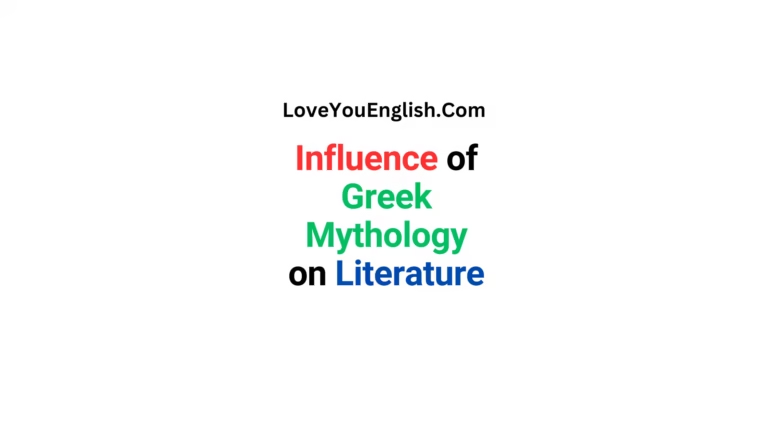The Portrayal of the Outsider in English Literary History
Sharing is caring!
In English literature, the theme of the outsider has been explored in many ways over centuries. From the medieval period to modern literature, writers have depicted individuals or groups who are on the outside of society, sometimes rejected or misunderstood.
These outsiders often face struggles, but they also reveal important truths about society. The portrayal of outsiders helps readers understand human nature, the dynamics of society, and the difficulties of living outside the norms.
In this post, we’ll explore how outsiders have been represented in English literature and why their stories are still relevant today.
What is an Outsider?
An outsider is someone who doesn’t fit into the mainstream society. This could be due to race, class, gender, or behavior that is different from what is considered normal or acceptable. Outsiders may be physically, mentally, or emotionally different, but they all face rejection or isolation in some way. These characters are often seen as “other,” which means they are not part of the dominant group or culture.
Throughout history, the portrayal of outsiders in literature has changed based on the social, political, and cultural environment of the time. In many cases, these characters challenge the rules and show the flaws in society, which can make their stories powerful and thought-provoking.
The Outsider in Early English Literature
In early English literature, outsiders were often portrayed as villains, sinners, or characters who were punished for their differences. During the medieval period, the concept of the outsider was heavily influenced by religion and the strict social systems of the time.
One of the most famous early examples of the outsider in English literature is the character of The Pardoner in Geoffrey Chaucer’s The Canterbury Tales (late 14th century). The Pardoner is a religious figure, but he is corrupt and deceitful, selling fake religious relics to the people. His actions make him an outsider, even though he is part of the church. Through this character, Chaucer highlights how people who are outwardly part of society can still be on the outside because of their immoral behavior.
In medieval literature, the outsider was often used as a moral lesson. Characters who went against the rules, such as outcasts or rebels, were punished in the end. For example, in the famous Arthurian legends, characters like Sir Lancelot sometimes stand apart from the group because of their actions or feelings of guilt. Though knights of the Round Table are celebrated, their internal struggles make them outsiders in their own ways.
The Outsider in Shakespeare’s Works
William Shakespeare (1564–1616) is one of the most important figures in English literature, and his works feature several examples of outsiders. Shakespeare often portrayed outsiders in a more complex way, showing that being on the outside was not always a negative thing, but a situation that revealed deeper truths about human nature and society.
In The Merchant of Venice, the character of Shylock, a Jewish moneylender, is one of the most famous literary outsiders. In Elizabethan England, Jews were outsiders because of their religion, and Shylock’s portrayal in the play reflects the prejudice of the time. He is depicted as a villain, but Shakespeare also shows how Shylock’s bitterness stems from the mistreatment he faces. His outsider status challenges the audience to reflect on issues of justice, mercy, and prejudice.
Another famous Shakespearean outsider is Hamlet. In Hamlet, the Danish prince feels disconnected from the people around him. He questions the purpose of life, the nature of revenge, and his place in the world. Hamlet’s internal struggles and his refusal to accept the political and moral norms of his society make him an outsider. While Hamlet is not physically different from those around him, his philosophical stance and refusal to conform to societal expectations make him feel isolated.
Romanticism and the Outsider
The Romantic period (late 18th century to early 19th century) was marked by an emphasis on individualism, emotion, and nature. During this time, the outsider became a more sympathetic and heroic figure. Romantic writers often celebrated the idea of the outsider as someone who stood against the constraints of society and embraced personal freedom.
One of the most famous examples of the outsider in Romantic literature is Frankenstein by Mary Shelley (1818). The creature in Frankenstein is born an outsider because of his appearance and unnatural origin. Despite his initial innocence, society rejects him, and he becomes bitter and vengeful. Shelley uses the creature’s story to explore themes of loneliness, alienation, and the consequences of playing god. Through the creature, Shelley examines how society’s treatment of outsiders can shape their lives and decisions.
Similarly, Byron’s Childe Harold’s Pilgrimage (1812) features the figure of the solitary traveler who rejects the conventions of society and goes on a journey of self-discovery. This outsider, though deeply troubled, is presented as someone seeking truth and freedom, away from the societal pressures of the time.
The Outsider in Victorian Literature
During the Victorian era (1837–1901), literature became more focused on social issues, class distinctions, and the struggles of individuals in a rapidly changing world. The outsider in Victorian literature is often someone who does not fit into the rigid class system or the expectations of society.
In Charles Dickens’ Great Expectations (1861), the character of Pip is an outsider because of his low social status and humble beginnings. Though he rises to wealth, his internal struggle and desire to become a gentleman create a tension between his true self and the expectations of society. His outsider status is highlighted by his interactions with people from different social classes, and he must navigate the complexities of identity, class, and social mobility.
Another key example of the outsider in Victorian literature is Dr. Jekyll and Mr. Hyde by Robert Louis Stevenson (1886). Dr. Jekyll, a well-respected scientist, creates an outsider in the form of Mr. Hyde, a monstrous alter ego who represents his darker, repressed desires. The novella explores the idea of duality in human nature and how society forces individuals to suppress their true selves. Dr. Jekyll’s transformation into Mr. Hyde reveals the tension between public persona and private desires, making him both an insider and an outsider.
The Outsider in Modern Literature
In the 20th century, the outsider became a central figure in modernist literature. Writers began to explore more deeply the alienation and isolation that individuals felt in the modern world. The rise of individualism and the questioning of traditional values made the outsider a complex and multi-dimensional figure.
One of the most famous examples of the outsider in modern literature is George Orwell’s 1984 (1949). The protagonist, Winston Smith, lives in a totalitarian society where independent thought is forbidden. Winston’s desire for freedom and truth makes him an outsider in a world of control and surveillance. Orwell’s novel examines the dangers of totalitarianism and the consequences of living outside the norms imposed by society.
Similarly, in J.D. Salinger’s The Catcher in the Rye (1951), the character of Holden Caulfield is a teenager who feels disconnected from the adult world. He struggles with the pressures of growing up and rejecting societal expectations. Holden’s journey as an outsider reflects the angst and confusion that many young people feel as they search for meaning in a complex world.
Why Outsiders Matter
The portrayal of outsiders in English literature serves many purposes. Outsiders challenge societal norms and expectations, often forcing readers to reflect on the flaws and injustices of society. They give voice to those who are often overlooked or misunderstood. Outsiders can also serve as mirrors for the reader, showing them aspects of themselves that they may not want to confront.
Moreover, the outsider’s story often offers a unique perspective. While insiders may see things from within the system, outsiders provide a fresh viewpoint that challenges the status quo. Their struggles remind us of the importance of empathy and understanding, and they encourage us to question the assumptions that guide our lives.
Conclusion
The portrayal of the outsider in English literature is rich and diverse, offering insights into human nature, society, and the struggles of individuals. Whether they are seen as villains, heroes, or tragic figures, outsiders play an important role in shaping the themes and messages of literature. From the medieval period to the present day, the outsider has been a symbol of both alienation and resistance. Their stories remain relevant today, encouraging readers to think critically about the world around them and their place within it.
More topics:
- The Role of the Supernatural in English Literary Classics
- The Role of Letters and Diaries in English Literary Narratives
- An Introduction to English Literature
- The Victorian Age in English Literature
- The Romantic Period in English Literature
Resources:
- Victorian Literature and Culture
http://www.victorianweb.org - Modernist Literature Resources
https://modernism.research.yale.edu - Full-Text Literary Works and Criticism
https://www.proquest.com/literatureonline
Sharing is caring!







